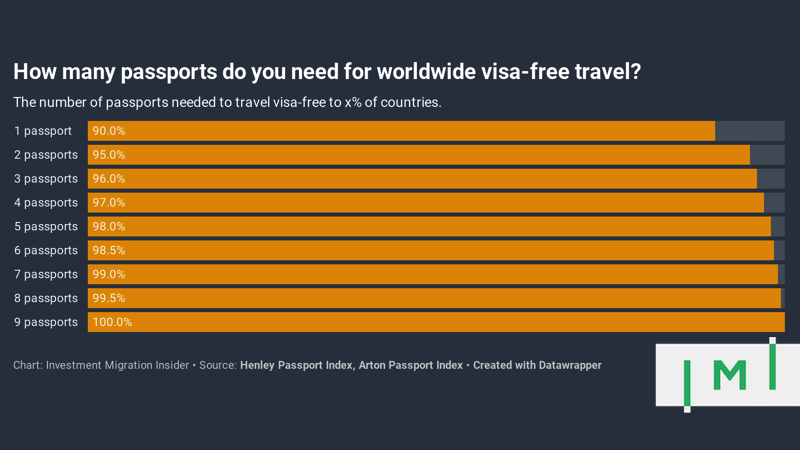The 9-Passport Combo That Gives You Worldwide Visa-Free Travel
Even the most travel-friendly passports leave 20-odd countries beyond your visa-free reach. What is the lowest number of passports that, combined, give you visa-free travel to all the world’s countries?
Method and assumptions
First, we’ve decided that, for the purposes of this analysis, we will define e-visa and visa-on-arrival as “visa-free”. Some readers may take issue with this broadened definition, and they are welcome to submit their own analysis based on more stringent criteria.
We took into consideration both the Henley & Partners Passport Index and the Arton Capital Passport Index. The former includes 227 territories, 28 of which are not countries. Since Arton’s index measures only countries, we have excluded H&P’s 28 non-country destinations from our analysis so as to enable apples-to-apples comparisons.
We started by considering the Japanese and United Arab Emirates passports because they are the two top-flight passports that have the least overlap between them in terms of the destinations covered (28 destinations offer visa-free access to one and not the other), making them highly complementary.
For example, the UAE has visa-on-arrival or e-visa access in many African countries where the Japanese need to apply in advance, while the reverse is true when it comes to Latin-America and Asia.
Where there were discrepancies between the two indices – where one indicates neither the Emirati nor the Japanese passport need visas to visit a particular country, while the other indicates one or both of them do – we have given that passport the benefit of the doubt. This was the case in the following instances:
- Arton’s index says Emirati passport holders have visa-free/e-visa/visa-on-arrival access to Burkina Faso, Burundi, DR Congo, Niger, and South Sudan, while Henley’s index states this is not the case.
- Arton’s index says both the UAE and the Japanese passports have visa-on-arrival in Nigeria, while Henley says neither do.
Getting to 100%
Between them, the Emirati and Japanese passports grant visa-free travel to all but 10 of 199 countries (remember, we are not including non-country territories like St. Helena, Guam, or French Polynesia).
With just two passports, then, it’s possible to visit about 95% of the world’s destinations.
The remaining countries – those to which neither the UAE nor Japan have visa-free access – are:
- Afghanistan
- Algeria
- Bhutan
- Cameroon
- Eritrea
- Ghana
- Iraq
- Libya
- North Korea
- Turkmenistan
The question then becomes; what is the lowest number of additional passports needed to cover the rest?
To answer that question, we start by looking for passports that can cross as many of the above countries as possible off the list.
No single country has visa-free access to more than two of the remaining countries. Those who hold a Ugandan, Sudanese, or Ethiopian passport, however, may cross both Ghana and Eritrea off their visa restrictions list.
Only the citizens of two countries can visit Iraq without a visa. These are Lebanon and Turkey. Turks can also visit Libya visa-free, so adding a Turkish passport will help cross two countries off the list.
Turkmenistan and North Korea are only accessible visa-free by the nationals of one country each; Georgia and China, respectively. Georgians can visit Turkmenistan without a visa-application and the Chinese can visit certain limited parts of North Korea without a visa for a few days at a time. We’ll need both a Georgian and Chinese passport to cross a further two countries off the list.
Now, with six passports – Japan, UAE, Uganda/Sudan/Ethiopia, Georgia, China, and Turkey – the only countries still off-limits are:
- Afghanistan
- Algeria
- Bhutan
- Cameroon
Passport holders from only seven countries can visit Cameroon without a visa, none of which are among our current four nationalities, which means we’ll need to add another passport to our portfolio. Is there a passport that can cross off more than one of the four remaining countries? Yes, but only one; that of Mali, which has visa-free access to both Cameroon and Algeria. We’ll therefore add Mali to our list of passports.
With a repertoire of five passports – Japan, UAE, Uganda/Sudan/Ethiopia, Turkey, and Mali – only Afghanistan and Bhutan remain inaccessible.
Bhutan allows for freedom of movement for three countries only; India, Bangladesh, and the Maldives. Since none of those have access to Afghanistan, we can pick either one.
Now, Afghanistan is the toughest nut of all to crack. We regret to say that zero countries have visa-free access to Afghanistan for ordinary passport holders. The only exemptions are travelers born in Afghanistan, born to Afghan parents, or with parents born in Afghanistan.
The only way to reach 100% global visa-freedom, therefore, is to become Afghani yourself or be born in Afghanistan, or have Afghani parents.
Final tally
To visit 100% of the world’s countries without first applying for permission, you’ll need the following nine passports:
- Afghanistan
- China
- Georgia
- Japan
- Mali
- Turkey
- UAE
- Uganda or Sudan or Ethiopia
- India or Bangladesh or the Maldives
If you are either Afghani, Turkmen, or North Korean, you can reduce that to eight.
Of course, other passport combinations are possible as well. Readers who can find a combination of passports that require fewer than nine to visit 100% of the world’s countries are invited to submit their analysis directly to the editor on cn@imidaily.com.
More about passport scores and indices:
- The Passport Index-Index – An Overview of Passport Rankings
- Quality of Nationality Index Becomes Media Favorite – That’s Good News
- The Most Powerful CIP-Country Passports by Accessible Sq. Km of Landmass
- The First Passport to Offer Worldwide Visa-Free Travel
- Analysis: Is the UAE Passport REALLY the World’s Strongest?


